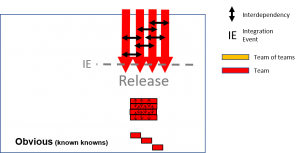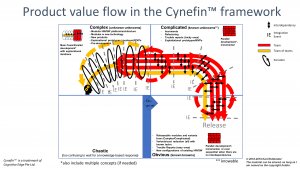In the Obvious domain we know exactly what to do, since we have done it before in a very similar way. This means that we can predict the time left until we can have the final Integration Event before the release. If we cannot predict it better than the predictions in the Complicated domain, we are most probably still in the Complicated domain, and if we not understand that, the risk is that we accidentally will end up in the Chaotic domain.
 Here as well, we can have fully parallel development to finish the task fast, but of course we then need to have control over our interdependencies. In the Obvious domain we can even do sequential development with waterfall way of working, when appropriate.
Here as well, we can have fully parallel development to finish the task fast, but of course we then need to have control over our interdependencies. In the Obvious domain we can even do sequential development with waterfall way of working, when appropriate.
Development that starts directly in the Obvious domain can for example be:
– Releasable modules and variants (started in Complex/Complicated)
– Variants/cost reduction with known technology
– Trouble reports (easy ones)
– New configurations of existing HW/SW
Between the mentioned domains, there can also always be loop backs, context switches due to unclarities or uncertainties. Here is a picture of the total Product value flow in the Cynefin™ Framework, with also some examples of common problems to solve for the different domains.

Multiple concepts thinking, since long time used at Toyota’s product development, is one way to reduce the risk for failure of the whole car, and can be referred also to both complexity work and incremental development. As long as we have multiple concepts and one of them has low risk, we can at the same time also go for a riskier concept that uses for example a new technology. This means that the riskier concept may be in the Complex domain, but the low risk in the Obvious domain, and the product development of the whole car is therefore in the ordered domains with a predictable release date. In this way we can have incremental updates of the modules within the car.
In the next blog post there will be a wrap-up of this series of blog posts regarding Product value flow in the Cynefin™ Framework. C u then.

